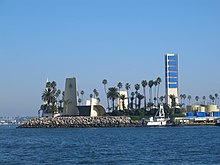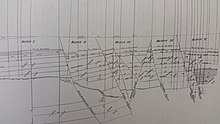Wilmington Oil Field



The Wilmington Oil Field is a prolific
The offshore portion of the oil field is developed largely through wells drilled directionally from
Operations
California Resources Corporation currently operates the Wilmington Oil Field in partnership with the State of California and the City of Long Beach. CRC's Long Beach operations include:[3]
- THUMS Long Beach Company, which operates the offshore portion of the Wilmington Oil Field
- Tidelands Oil Production Company, which operates the onshore portion of the Wilmington Oil Field
- two additional smaller leases in the Long Beach area
Data
Estimations as of 2013 (based on reserve estimates in 2008[4] and extraction from succeeding years,[5] estimated through July).
- cumulative production: 2,750 million bbl (437 million m3)
- estimated reserves: 235 million bbl (37.4 million m3)
- annual production: 13 million bbl (2.1 million m3)
- producing wells: 1,428 (in 2008)
- estimated year of depletion (based on current rates and reserve estimates): 2031
A 2013
Geology


The field was discovered with the Ranger Petroleum Corp.'s Watson No. 2 well in 1932, which flowed at 150 bbl per day, and the broad
Subsidence
Withdrawal of large volumes of oil from the poorly consolidated sediments resulted in compaction of the oil reservoirs, and resultant sinking of the overlying land surface. Subsidence became apparent in 1940, and exceeded 20 feet at the center. Water injection to maintain pressure in the oil reservoirs began in 1953, which eventually stopped further subsidence.[7]
References
- ^ Otott, George E. Jr & Clarke, Donald D. (1996) "History of the Wilmington Field – 1986–1996". In AAPG Pacific Section, Old Oil Fields and New Life: A Visit to the Giants of the Los Angeles Basin, pp. 17–22.
- ^ "Historical - oil operations". City of Long Beach. Retrieved 2009-04-30.
- ^ California Resources Corporation 2017 Annual Report. Pages 16-25.
- ^ "Great Oil Fields". Los Angeles Almanac. Given Place Media. 31 December 2008. Retrieved 26 August 2013.
- ^ "2012 Preliminary Report of California Oil and Gas Production Statistics" (PDF). Department of Conservation: Division of Oil, Gas, and Geothermal Resources. April 2013. Retrieved 26 August 2013.
- ^ Remaining Recoverable Petroleum in Ten Giant Oil Fields of the Los Angeles Basin, Southern California, USGS, revised 2-2013
- ^ a b c Mayuga, M.N., Geology and Development of California's Giant-Wilmington Oil Field, in Geology of Giant Petroleum Fields, Tulsa: American Association of Petroleum Geologists, Memoir 14, p. 159.
- ^ Mayuga, M.N., p. 167.
- ^ Mayuga, M.N., pp. 167-169.
- ^ Mayuga, M.N., pp. 163-164.
- ^ Mayuga, M.N., p. 166.
